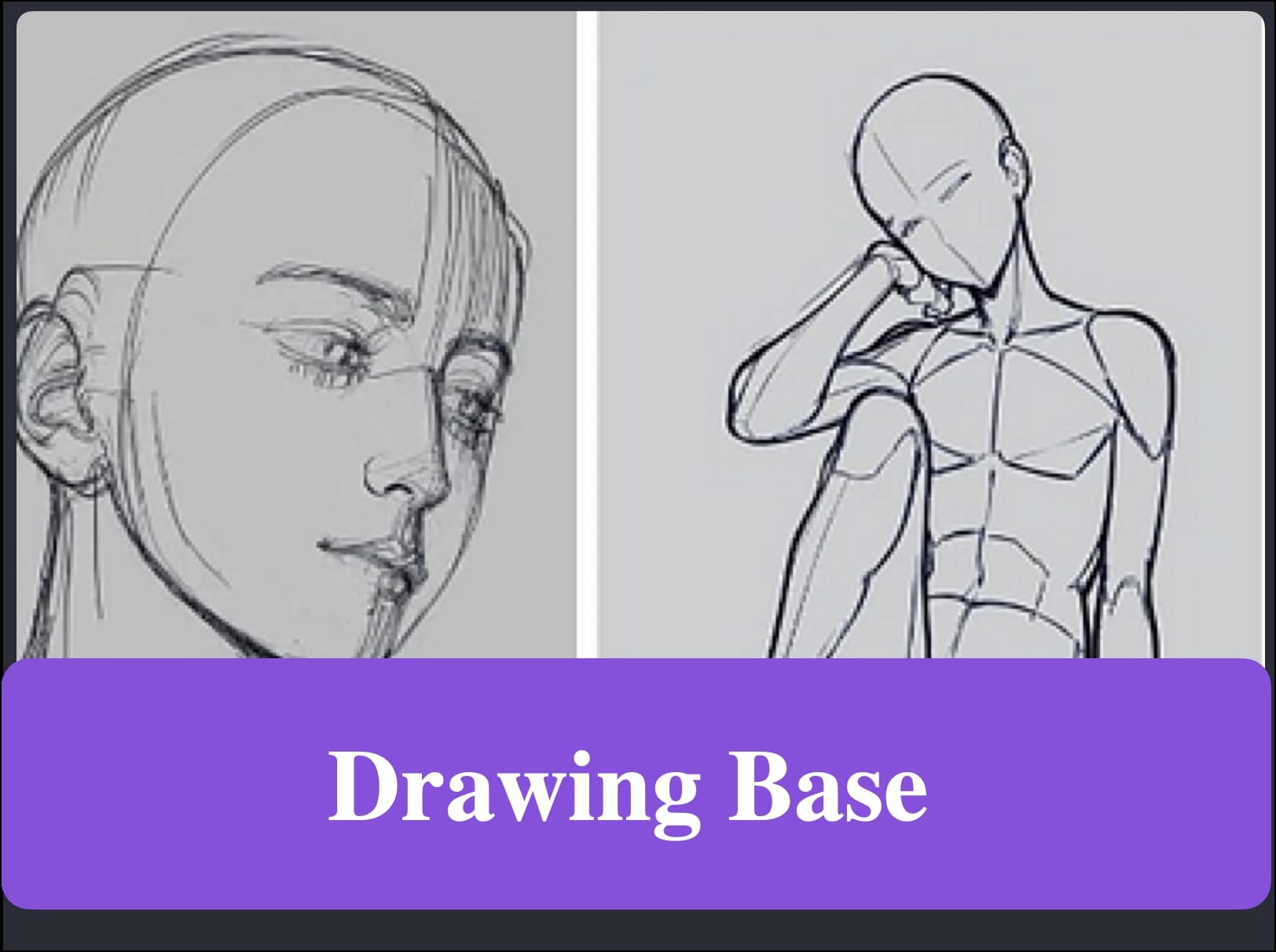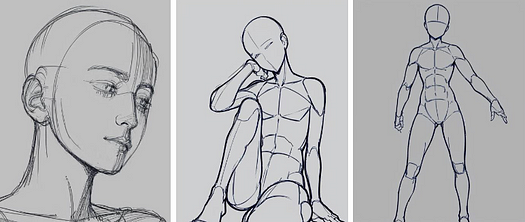Drawing Base Inspiration: Unique Poses & Techniques

Unleash your creativity with diverse drawing base inspiration. Discover new poses and techniques to enhance your artwork.
When it comes to drawing, having a strong foundation is essential for creating captivating and impactful artwork. The way artists approach their base sketches, proportions, techniques, and even their use of props and clothing can greatly influence the final outcome of their drawings. In this blog, we will explore various aspects of drawing bases, from understanding their significance in art to avoiding common mistakes, and enhancing drawings through expressions and palettes. Whether you’re a beginner or an experienced artist, this blog aims to provide you with valuable insights and inspiration to take your drawing skills to the next level.

Understanding the Basics of Drawing Bases
When browsing through the incredible artwork created by talented artists, you may wonder how they bring their characters to life with such precision and detail. The answer lies in their understanding of the basics of drawing bases. By starting with a well-constructed base sketch, creators are able to establish the overall composition, accurately depict proportions, and ultimately, convey the desired pose and emotion.
Significance of Base Sketches in Art
Base sketches serve as the framework for more intricate drawings, enabling artists to establish the initial composition, proportions, and poses. They provide a solid foundation upon which creators can build their artwork, ensuring accuracy and cohesiveness. By incorporating base sketches, artists lay the groundwork for expressing movement, energy, and emotions in their art. Understanding the significance of base sketches is crucial for honing drawing skills and creating captivating artwork.
Incorporating Proportions and Anatomy in Bases
Incorporating accurate proportions and anatomy in base sketches is fundamental for realistic artwork. It allows creators to depict human figures authentically, ensuring the correct alignment and scale of body parts. By paying close attention to proportions and anatomy, artists can create lifelike and dynamic poses, adding depth and realism to their art. Understanding and mastering these aspects of base sketches are invaluable skills for every artist.

Exploring Various Drawing Technique
Once you grasp the importance of base sketches, it’s time to explore various drawing techniques that can elevate your artwork. These techniques not only enhance the visual impact of your drawings but also enable you to convey movement, energy, and emotions more effectively.
The Art of Gesture Drawing
Gesture drawing, also known as hour drawing, is an essential technique that captures the essence and movement of the subject in a quick and fluid manner. It requires spontaneity and precision, enabling artists to portray the energy and dynamics of a pose effectively. With gesture drawing, creators focus on capturing the essential gestures and expressions, allowing for a more expressive and dynamic representation of the human form.
Integrating Movement and Energy in Drawings
Integrating movement and energy in drawings is crucial for creating a sense of dynamism and action. By exploring various techniques, artists can infuse their drawings with vitality and liveliness, evoking a captivating visual experience. Anime artists, in particular, excel at conveying movement and energy in their artwork, drawing inspiration from browsing through various references, such as anime and pinterest, to master the art of portraying motion and capturing the viewer’s attention.

The Role of Props and Clothing in Drawings
Elevate your artwork by recognizing the pivotal role of props and clothing. The inclusion of these elements adds depth and context to your illustrations, allowing for a richer narrative. Props can serve as storytelling devices, providing insight into a character’s personality or the overall theme of the artwork. Meanwhile, clothing not only contributes to character identity but also offers opportunities for artistic expression through style, texture, and color. Understanding the significance of props and clothing enhances the overall visual impact of your drawings.
Techniques for Drawing Poses with Props
Explore techniques that infuse your artwork with complexity and interest through integrated prop poses. When incorporating props into poses, consider the interaction between the character and the object. This dynamic relationship can convey emotions, actions, or narrative elements. Whether it’s a character holding a key prop or interacting with a significant object, mastering these techniques adds layers to your drawings, making them more engaging and visually compelling.
Adding Realism through Clothing and Drapery
Achieve realism in your drawings by paying attention to clothing and drapery. Capturing the natural movement and flow of fabric brings authenticity to your characters and scenes. Understand the principles of how clothing behaves in different poses and environments, considering factors such as gravity, wind, and body movement. This attention to detail not only enhances the overall realism of your artwork but also contributes to texture and visual authenticity. By mastering the art of depicting clothing and drapery, you breathe life into your characters and create a more immersive visual experience for your audience.

Avoiding Common Mistakes in Base Sketching
Steer clear of common pitfalls in base sketching by being mindful of prevalent mistakes. Identifying and avoiding issues such as disproportionate limbs, misaligned features, or inconsistent perspectives is crucial. Maintain a keen eye for symmetry and balance in your base sketches. By sidestepping these common errors, artists can lay a solid foundation for their artwork and ensure a more accurate representation of the intended subject.
Simplifying Complex Forms and Designs
Tackle intricate forms and designs with finesse by incorporating simplification techniques. Utilize grids to establish precise proportions and alignment in your sketches. Breaking down complex shapes into more manageable components aids in maintaining clarity and coherence. Whether dealing with intricate objects or elaborate scenes, simplification ensures that the essential elements are conveyed effectively. This approach not only facilitates the drawing process but also enhances the overall readability of the artwork.
Correcting Proportional Errors Effectively
Address proportional errors in your sketches with a systematic approach. Regularly compare and assess different parts of your drawing to identify inaccuracies in proportions. Employ tools like measurement techniques and guidelines to ensure consistency. A thorough study of anatomy is invaluable in understanding the correct relationships between various body parts. When errors are detected, make adjustments gradually to maintain overall harmony. Seeking objective feedback from peers or mentors provides valuable insights and aids in refining your skills, contributing to continuous improvement in achieving accurate proportions in your artwork.

Enhancing Drawings with Expressions and Palettes
Elevate your drawings creatively by delving into a variety of expressions and palettes. Experimenting with different color schemes and expressive features adds depth and emotion to your artwork. This exploration not only enhances the visual impact of your drawings but also allows for a broader range of creative possibilities. Whether you’re conveying mood, tone, or narrative, the careful selection of expressions and palettes contributes to the overall artistic richness of your illustrations.
Emphasizing Facial Features and Expressions
Master the art of emphasizing facial features and expressions by delving into facial anatomy. Study the intricacies of the face in-depth, paying attention to subtle details that contribute to emotional expression. Experiment with diverse drawing techniques, incorporating shading and highlighting effectively to convey depth and emotion. Regular practice in capturing a variety of expressions enhances your versatility as an artist, allowing you to breathe life into characters and evoke specific emotional responses from your audience.
Selecting Appropriate Color Palettes
Choose color palettes thoughtfully, considering various factors such as mood, contrast, harmony, psychology, and symbolism. The selection of colors significantly influences the emotional impact and visual coherence of your drawings. Tailor your color choices to match the intended atmosphere of the piece, utilizing contrasting colors for emphasis or harmonious palettes for a soothing effect. Understanding the psychology of colors and their symbolic meanings empowers you to convey nuanced messages and enhance the overall storytelling within your artwork.

How Can Practice Improve Your Base Drawing Skills?
Regular practice is crucial for improving your base drawing skills. Not only does it enhance muscle memory and hand-eye coordination, but it also allows you to refine and hone your drawing techniques. Drawing from life and observation helps develop your observational skills, while revisiting previous work allows for reflection and improvement. Additionally, experimenting with different mediums and styles fosters creativity.
Conclusion
In conclusion, mastering the art of drawing bases is essential for any artist looking to create dynamic and realistic artwork. Understanding the basics of proportions, anatomy, and movement is crucial in creating a solid foundation for your drawings. Additionally, incorporating props, clothing, and expressions adds depth and realism to your artwork. Avoiding common mistakes and continuously practicing will help you improve your base drawing skills over time. Remember, drawing is a journey, and it’s important to embrace the process and enjoy every step of the way. So keep practicing, experimenting, and pushing your boundaries to create unique and inspiring artwork. Happy drawing!
novita.ai provides Stable Diffusion API and hundreds of fast and cheapest AI image generation APIs for 10,000 models.🎯 Fastest generation in just 2s, Pay-As-You-Go, a minimum of $0.0015 for each standard image, you can add your own models and avoid GPU maintenance. Free to share open-source extensions.
Recommended reading